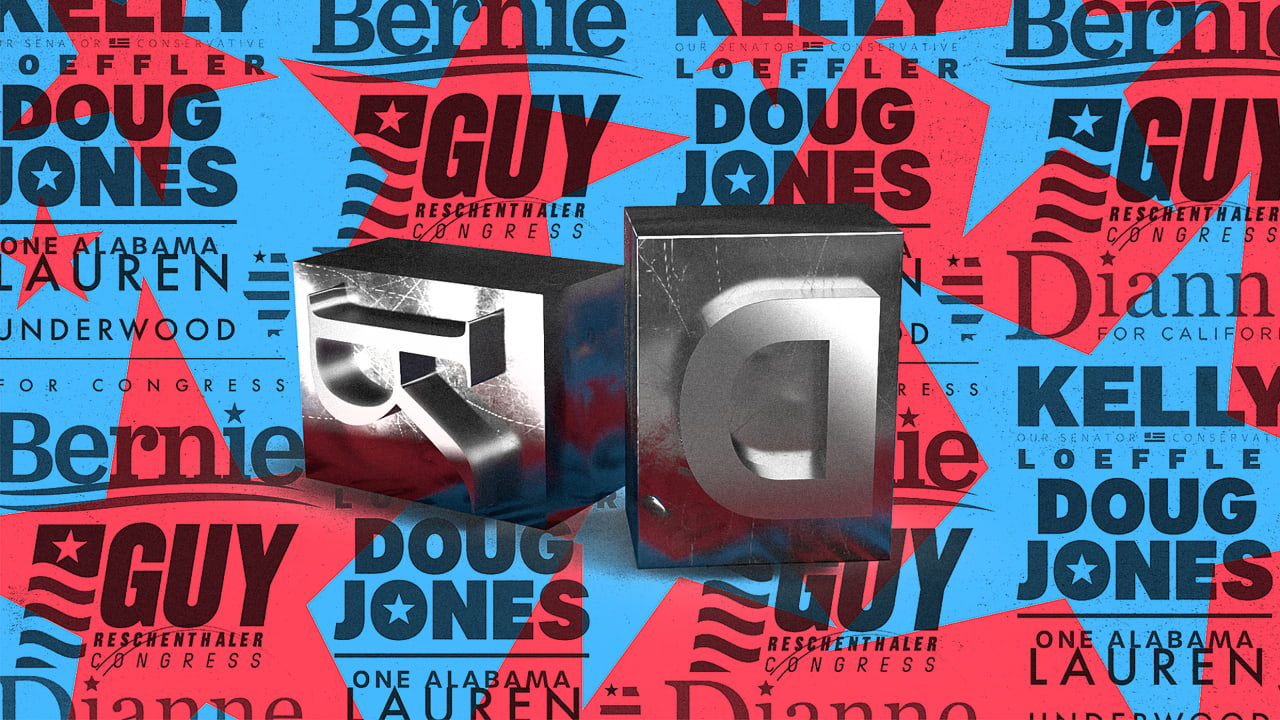The real politics of type - 5 minutes read
 Typefaces can be conservative or liberal. But there's a lot more to it
Typefaces can be conservative or liberal. But there's a lot more to itA recent study by Virginia Tech professors Katherine Haenschen and Daniel J. Tamul indicates that people make assumptions about candidates based on the typefaces they use. The study asked 987 people to rate varying typefaces as conservative or liberal in a series of two experiments and found that people do “perceive typefaces, type families, and type styles to have ideological qualities.”
For example, Blackletter, a sharp serif, was rated most conservative; Sunrise, a bubbly sans serif, was rated most liberal. But the particular characteristics of individual letterforms are interpreted ideologically as well. Generally, according to the study, serifs are rated as more conservative and sans serifs as more liberal. And not even typography can escape the political polarization we face today: In this study, a typeface received a better rating when it was thought to be from the same ideological persuasion as the reviewer. Okay, so there’s not much crossing of the aisle here either, huh?
But while this study asked participants to rate typefaces as liberal or conservative, the reasons certain typefaces are chosen over others isn’t so obvious. According to the authors, it also has to do with underlying psychological and personality traits people associate with a liberal or conservative choice and how those are conveyed visually. There’s even more typographic nuance to dig into here than a simple serif-sans serif dichotomy.
Although the Virginia Tech study indicated that sans serifs are perceived to be more liberal than their serif counterparts, they’re actually used in similar quantities by both parties. According to data from the Center for American Politics and Design, 68% of Democrats and 62% of Republicans use sans serif typefaces. Not a major difference. According to Susan Merriam, cofounder of CAPD, stylistic choices within those classifications are often a better indicator of political persuasion.
Sure, serif fonts were rated as more conservative than sans serifs in the study. But as any political theorist will tell you, having a more conservative or liberal point of view doesn’t mean you’re automatically a card-carrying member of the Republican or Democratic party. That tracks here too. According to Merriam, if a candidate uses a serif typeface, that person might be trying to convey a sense of tradition and authority. Yes, those are common traits of Republican candidates. They’re also common traits of senior-ranking politicians. Merriam lists Dianne Feinstein and Nancy Pelosi as two Democratic examples that use serifs. Does that come as a surprise to anyone?
So if both Republicans and Democrats use sans serifs in similar amounts, what is the differentiating factor? According to Merriam, it’s the weight of the typeface. Republican branding, as seen with Senator Kelly Loefler and President Trump, leans toward a very hefty-weight sans serif. That’s as compared to thinner-weight sans serifs, which are more likely to be used by a Democrat. (Merriam cites Lauren Underwood, Jamie Schoolcraft, and Zoe Lofgren’s logos from 2018 as examples.)
Senator Marco Rubio used a geometric sans serif for his 2016 campaign. And while the application of a modernist font might be surprising, it has to do with the underlying message Rubio wanted to convey: “likely using type associated in people’s minds with space movies to indicate that he is a forward-looking choice within the Republican party,” says Merriam. I’ll leave it up to you as to whether Rubio is a forward-looking candidate, but the visual application works well as a subliminal cue for the message he wanted to convey. No serifs here, people! There are other interesting outliers: Beto O’Rourke used condensed sans serif; Bernie Sanders opted for Jubilat, a heavy slab serif. All to say that the whole sans serif versus serif binary? It only scratches the surface.
Source: Fastcompany.com
Powered by NewsAPI.org
Keywords:
Conservatism • Liberalism • Virginia Tech • Texas A&M International University • Conservatism • Liberalism • Perception • Type family • Ideology • Blackletter • Conservatism • Sans-serif • Liberalism • Individualism • Serif • Conservatism • Serif • Liberalism • Typography • Polarization (politics) • Typeface • Ideology • Persuasion • Aisle • Liberalism • Conservatism • Psychology • Liberalism • Conservatism • Choice • Typography • Sans-serif • Dichotomy • Virginia Tech • Liberalism • Democracy • Republican Party (United States) • Sans-serif • Typeface • Style (visual arts) • Choice • Persuasion • Serif • Conservatism • Experiment • Political philosophy • Conservatism • Liberalism • Point of view (philosophy) • Religious education • Republican Party (United States) • Democratic Party (United States) • Serif • Typeface • Republican Party (United States) • Dianne Feinstein • Nancy Pelosi • Democratic Party (United States) • Serif • Republican Party (United States) • Democratic Party (United States) • Serif • Typeface • Republican Party (United States) • Robert Kelly (comics) • Sans-serif • Serif • Democratic Party (United States) • Zoe Lofgren • Logo • United States Senate • Marco Rubio • Sans-serif • United States presidential election, 2016 • Modernism • Font • Republican Party (United States) • The Forward • Beto O'Rourke • Sans-serif • Bernie Sanders • Jubilat • Slab serif • Sans-serif •